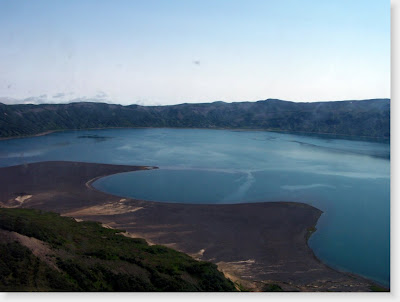Brief
Geologic History of Karymsky
Karymsky Volcano occupies the majority of the 5 km diameter Karymsky caldera
and is part of a larger volcanic center. The caldera formed approximately 7.9 kyr after
a catastrophic eruption. Lavas, pyroclastic density currents (PDCs), and fall out
deposits built the modern cone of Karymsky throughout the last 5300 years
(Izbekov et al., 2004). Much of the cone
is mantled with lava flows less than 200 years old (Global Volcanism
Program).
Karymsky Lake, 60 m deep, is located 9 km to the south and occupies
the Academy Nauk Caldera. The caldera
formed due to a large eruption 28-48 kyr ago and has remained relatively quiet
ever since (Izbekov et al., 2004).
Karymsky was extremely active throughout the 20th century
and continues in activity today.
Explosive and effusive activity was common during 1908-1915, 1921-1925,
1929-1935, 1943-1947, 1952-1967, 1970-1982, and 1996-present (Izbekov et al.,
2004).
Year(s)
|
VEI
|
Behavior
|
1908-1915
|
2
|
Central
vent eruptions, explosive, lava flows
|
1921-1925
|
2
|
Central
vent eruptions, explosive
|
1929-1935
|
2
|
Central
vent eruptions, explosive, lava flows
|
1943-1947
|
2
|
Central
vent eruptions, explosive, lava flows
|
1952-1967
|
3
|
Central
vent eruptions, explosive, lava flows
|
1970-1982
|
3
|
Central
vent eruptions, explosive, PDCs, lava flows, lava dome, lahars
|
1996-Present
|
3
|
Central
vent eruptions, explosive, PDCs, lava flows, lava dome
|
1996-
Current Eruption
The most recent
and perhaps most interesting eruptive cycle of Karymsky started in January 1996
and continues at present. In March 1995,
after 13 years of dormancy, a significant increase in volcano-tectonic
earthquakes occurred at both Karymsky and Academy Nauk caldera, 6 km to the
south (Eichelberger and Izbekov, 2000).
After several months of unrest, the number of seismic events increased
abruptly and culminated in a 6.6 magnitude earthquake on January 1, 1996,
located 17 km south at 10 km depth. The
earthquake occurred along the same fault that connects Karymsky volcano and Academy
Nauk caldera (Izbekov, 2004).
On January 2,
Karymsky began to erupt a steady gas-and-ash column from the summit, forming a
3 km high umbrella cloud, which drifted east from the volcano. Shortly after, a separate eruption began and
formed a new vent in the northern portion of Academy Nauk caldera beneath the
lake surface (Izbekov, 2004). The
Karymsky vent and the newly formed Academy Nauk vent produced simultaneous eruptions
for the following 18 hours. Karymsky
continued to emit a continuous ash plume, while Academy Nauk generated periodic
phreato-magmatic eruptions. The phreato-magmatic
explosions lasted for 18 hours and sent juvenile and lithic bombs, ash, and water
vapor 8 km a.s.l. (Izbekov, 2004).
Despite the
termination of the eruption at Academy Nauk, the eruption, Karymsky continued
to erupt for the following 16 years until present day. During the first 6 weeks after the initial
eruption, eruptions remained frequent and unpredictable. Large vulcanian eruptions produced large ash
plumes and pyroclastic flows that extended down the flanks of the cone
(Izbekov, 2004). Since the onset of the
eruption, the volcano has undergone periods of strombolian-vulcanian style
eruptions with regular intervals between eruptions and very irregular explosive
vulcanian eruptions (Izbekov, 2004).
Geodetic measurements completed in the summer
following the initial eruption showed that the fault, along which Karymsky and
Academy Nauk are located, showed significant extension. The extension is thought to be the result of
a dike that slowly intruded the pre-existing fault directly beneath the two
vents (Eichelberger and Izbekov, 2000).
The intersection of the rising dike and the magma chamber beneath
Karymsky triggered the eruption in 1996 (Izbekov et al., 2004).
Current Activity
Karymsky volcano
remains very active today. Based on
seismic data and visual observations, approximately 45 strombolian-vulcanian
eruptions occurred in 2012 (Global Volcanism Program). Of all the reported and observed eruptions, Karymsky
ash plumes rose to an average height of 3.4 km a.s.l. A maximum observed ash plume height of 6.7 km
a.s.l. was observed on October 6, 2012.
 |
| Typical Vulcanian style eruption with a large ash plume and PDC, which can be seen cascading down the flanks of Karymsky volcano in October 2009 (Photo from Global Volcanism Program). |


.png)

.png)

.png)


thanks for the memories even though they wernt so great
ReplyDeleteI cant believe someone actually commented on this... anyway if your looking for a source for a research paper try easybib. Btw there is going to be a .porn and .adult added soon so if your reading this before that time... congrats i guess.
ReplyDelete